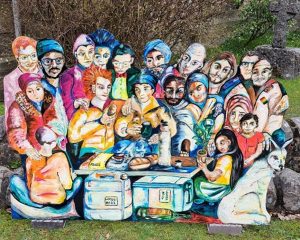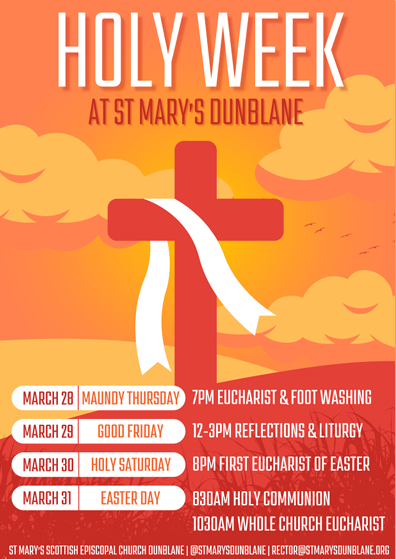Nerys writes, If I ever return to California, I would like to visit a church in San Francisco called St Gregory of Nyssa which has become well-known for a number of reasons. You may remember Bishop Ian speaking about its worship which features joyful singing and dancing by the whole congregation around the altar during the eucharist. It is also remarkable for its community work, especially for its ‘food pantry ministry’. Every Saturday, the church distributes fruit, vegetables and groceries to about 800 families in need in that part of San Francisco and with the encouragement and guidance of the team, these families are growing into supportive communities.
The inspiration for the food pantry came from a journalist called Sara Miles. She was brought up as an atheist. As an adult, she had no interest in becoming a Christian (or ‘a religious nut’ as she thought of it at the time). Then, early one Sunday morning in 1999, she wandered into St Gregory of Nyssa church and joined a service. At communion she received the bread and the wine and the experience transformed her life. She came to faith in Christ there and then and in the weeks and months that followed, she embraced the religion that she had previously scorned.
As she threw herself into the worship and community life of St Gregory of Nyssa church she discovered that Christianity isn’t all about the supernatural or good behaviour as she had been taught to believe. It’s about people – all kinds of people with real bodies and with real hunger, all longing to be fed spiritually, and some needing also to be fed with real food. Before long, the bread Sara Miles ate at that first communion had multiplied into tons and tons of groceries, piled up in the church, ready to be given away to people living in the poorest parts of the city. Under her leadership, the community of St Gregory of Nyssa set up a series of what we would call food banks whilst also seeking to draw attention to the scandal of hunger among working families who are not paid enough. In the book she later wrote about her experience which is called Take this bread, she says, ‘The mysterious sacrament turned out not to be a symbolic wafer but actual food – indeed the bread of life’.

I was reminded of this extraordinary story of coming to faith in Christ and putting that faith into action as I read today’s two passages from the pen of St Luke, Luke 24.36-48 and Acts 3.12-19. Just as it was the physical presence of the communion bread in her mouth that brought about the conversion of Sara Miles, it was the physical presence of Jesus in their midst that transformed his disciples. And, not only did they see him, hear his voice, and touch his body but he also invited them to eat with him.
Our translations read ‘he took a piece of broiled fish and ate it in their presence’, an act which I’ve always found rather strange. Where this unusual phrase happens again in Luke 13.26, it clearly means ‘to share a meal’. This interpretation seems to me more likely when we think of all the examples of table fellowship threading through this Gospel. Luke’s Jesus dines with tax collectors and other outcasts, with the Pharisees and other religious leaders, and of course, with his friends and disciples. So, understood in this way, the taking of the fish is not intended only as proof that he is not a ghost, but also as a reminder for his disciples of all the times when Jesus created community with them. It implies his acceptance of them despite their recent denial and desertion of him. It reminds them of the radical inclusion which he taught through his words and actions.
Eating the fish together with him may also have brought to their minds that first encounter on the shores of Lake Galilee when he called the fishermen to fish for people. And what about that time on the hillside when they witnessed five loaves and two broiled fish becoming a feast for thousands of hungry people? And, of course, that strange last meal in Jerusalem when he gave them the bread saying, ‘This is my body’ and the wine, saying, ‘This is my blood’.

The Lord’s Supper at Holy Trinity Church Pitlochry
As they eat together this last ‘Last Supper’, Jesus explains to them once more the significance of all that had happened in the previous three days. God had done something new and unexpected through him, and yet it was the same thing that God had always been doing in his dealings with his people Israel and the whole world. As they listen, they realise that all of Scripture points to the cross and the resurrection of Jesus. As they are reminded of the preaching of the prophets down the ages, they recall the words of John the Baptist and their own future roles start to become clear to them. Not only are they to testify to the risen Christ, but they are also to preach repentance and forgiveness of sins, as John did in words and as Jesus did through his actions also.
In our passage from the Book of Acts we see Peter doing exactly this in the precincts of the temple. He heals a man who was unable to walk and then uses the amazement of the onlookers as an opportunity to direct their attention to the life-changing power of faith in the risen Christ. They also can be set free and made whole by accepting the forgiveness now available to them through the death and resurrection of Jesus. This story has been included by Luke, not as an unusual or extraordinary event, but as a typical example of the apostles acting out what they were commanded by the risen Christ to do.
In today’s epistle, John also speaks as a witness – as someone who has experienced the presence of the risen Christ in his life – sharing with his readers what it is to be forgiven and to live as a beloved child of God. Today’s passage, 1 John 3.1-7, is a call to repentance, a call to become honest with God and ourselves. It is only then that we are able to see Christ as he is, in us and in those around us, and to seek to be as Christ-like as possible.
Following Christ is not easy, however, and not without cost as Luke demonstrates. It is to the hostile religious leaders of Jerusalem after a night in spent prison, that Peter’s next sermon is delivered. Preaching repentance and forgiveness of sins has consequences because it is not just a matter of encouraging individuals to change direction. It is about setting the whole world right – speaking truth to power, working for justice and lasting peace. We may feel powerless today in the face of the destruction of our planet and of such widespread violence, corruption and cruelty, but I believe that with every word and every non-violent action that witnesses to the risen Christ, the kingdom of God is coming into the world. We know that in areas of deep-set conflict, the only way towards reconciliation is repentance and forgiveness – the way of compassion that Jesus taught. It seems beyond belief, but that’s the point. When he was killed, it appeared to his followers that the powers of violence and death had silenced him for ever. But on the third day Jesus rose again, he came amongst them and commissioned them to be his voice, to continue his work. They responded with joy because they could see that he was alive and knew that somehow from now on he would always be with them. The risen Christ invites us also to join his community, to live always in his presence and to witness to him each in our own way in order to bring in God’s reign of peace on earth. I wonder what our response to this invitation is today?






